Developing Android apps can be a time-consuming process, but with these 6 tips for faster Android app development, you can speed up your workflow and improve efficiency.
The pros and cons of Android app development
Want to get into Android development? Well, you’ve made the right choice.
It’s one of the world’s most popular mobile operating systems, attracting billions of users and developers.
And getting into that user base is one of the best ways to increase your app’s chances of success.
But before you take the leap, you must know what you’re getting yourself into.
And it starts with familiarizing yourself with the pros and cons of Android development.
Table of Contents
The pros
Let’s first explore why 5.9 million developers (as of 2023) pick Android as their platform of choice.
Android has a large global market share
Market share is perhaps Android’s biggest advantage over every other mobile operating system out there.
That’s because Android is the undisputed leader in the space with a 70% market share, beating out everyone by a very wide margin. For example, the second placer is iOS at a mere 28.44%.
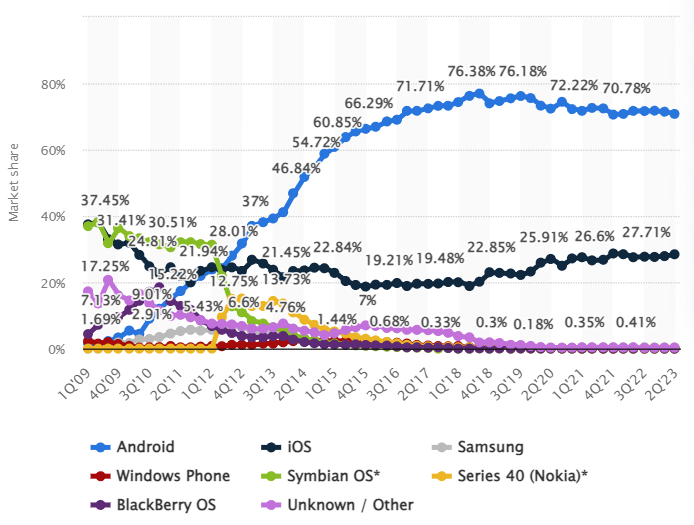
Source: Statista
The numbers are even more skewed in developing countries. For example, Android’s market share in Africa is a whopping 86.61%.
The main reason for Android’s dominance is its open-source nature. That gives any manufacturer the freedom to adopt Android into their smartphones or mobile devices.
As it turns out, this is one of the most effective ways to ensure something is ubiquitous.
In the case of developing countries, Android phones are significantly cheaper than Apple devices. This makes it far more accessible for poorer nations, further widening Android’s lead.
Contrast this with the closed ecosystem of iOS, which can only be used on Apple devices. Even though Apple is a powerful company, it can only do so much as a single entity.
If you’re a developer who wants to gain as many users as possible, picking Android is a huge advantage.
It gives you up to three times more exposure, which means that (theoretically) you should be able to triple your download rate.
The numbers back this up. In 2023 alone, Android generated 27 billion downloads, which is a far cry compared to Apple’s 8.1 billion.
There are lots of learning resources for Android
Having a huge market share and millions of developers benefits many things. One of them is having vast learning resources.
Google alone has phenomenal support behind Android.
It has a comprehensive developer guide that guides newbies on all aspects of Android programming, including examples, best practices, and tips.
The documentation even extends to UI design. Android’s style guidelines give you rules and principles to achieve great UX without trial and error.
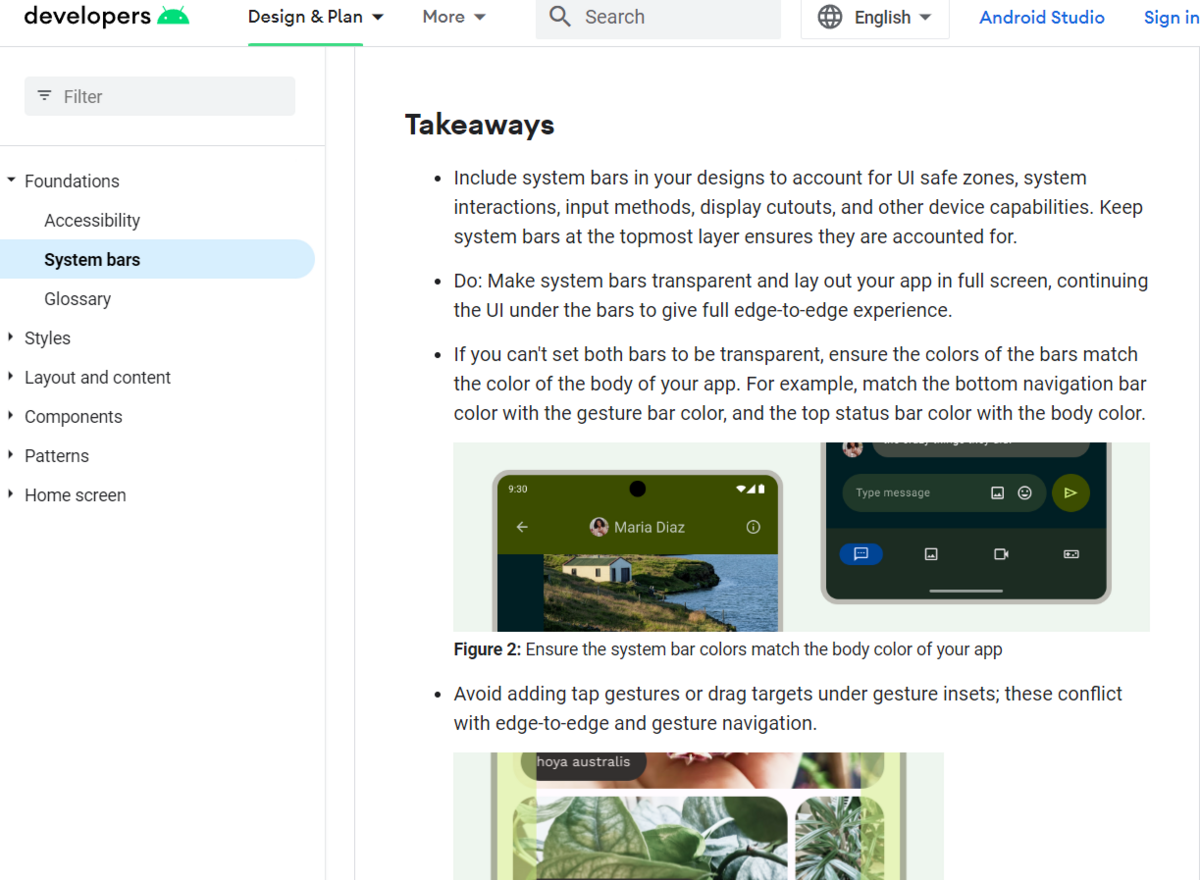
Source: Android
If you want something more formal, Google also offers the Google Developers Certification, a one-time test for evaluating your Android coding skills.
Not only can it measure your proficiency, but you can also prove it to future employers and clients.
And that’s just Google.
There are hundreds—if not thousands—of courses, books, and programs that can help you improve your Android development game.
Plus, there are also countless communities of Android developers you can join.
If you ever get stuck with a problem, chances are that someone in the community has already encountered it and can lend a helping hand.
This eases Android’s learning curve significantly, which only helps strengthen its market share.
The Google Play Store has a simple approval process
The Google Play Store’s approval process is noticeably more forgiving and flexible than its competitor, Apple App Store.
No surprise there, as Apple is known for having the strictest approval processes of all mobile platforms.
This is thanks to its closed ecosystem, which means it’s very selective of apps it allows into its gated world.
In 2022 alone, the App Store rejected over 1.7 million apps.
The reason for this is that Apple checks many more factors than Google. As we covered in this article, there are more than a dozen potential reasons for rejection.
Google, in contrast, is much more relaxed.
Now, it isn’t to say that the Google Play Store allows just any app on its platform. It does have strict content guidelines, which all apps must follow. But they’re not as demanding as Apple’s.
Here are other noticeable differences between the two app stores:
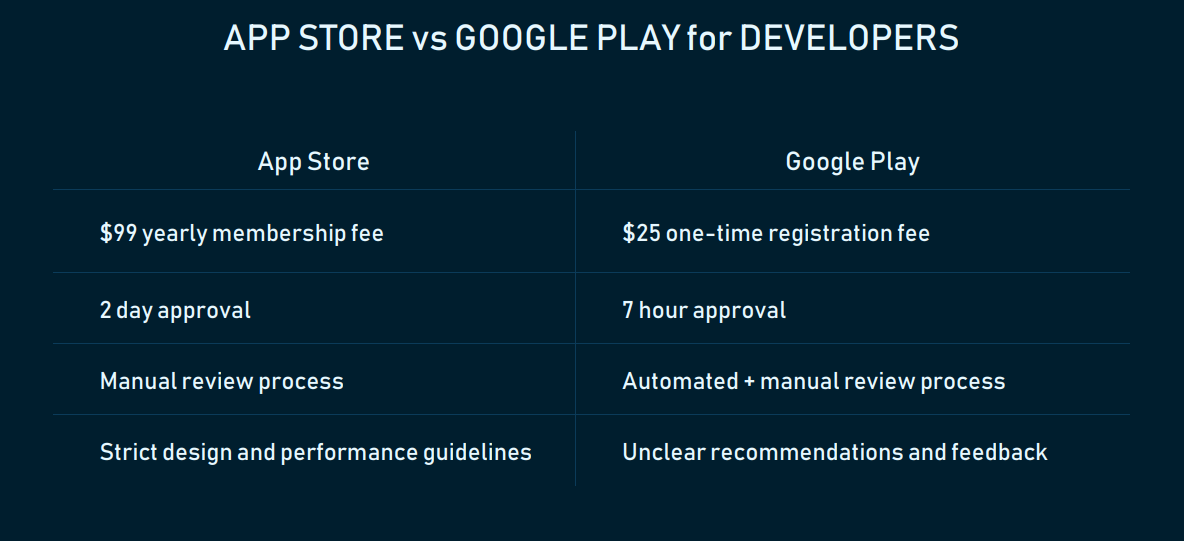
Source: Altexsoft
That makes Android a great platform for deploying minimum viable products (MVPs) without the risk of getting rejected (and therefore spending more time and effort fixing it).
It helps you launch and get more early feedback, which could build long-term success.
The cons
With all of Android’s strengths, it has disadvantages that turn off many developers. Here are three you must be aware of.
Android users spend less on average
Android might have a huge market share, but that advantage comes at a price. On average, its users have less spending power than those of iOS.
You can see this clearly in this study by Data.ai. In 2022, consumer spending on iOS apps was double that of Android. Check out the graph below:

Source: Digital Information World
Looking closely, you’ll see that it boils down to demographics.
A study has shown that the average iPhone user earns between $50,000 to $85,000 per year.
In contrast, the typical Android user has much less disposable income, with a salary ranging from $36,000 to $60,000.
And the big reason for this is that Android has a large but very diversified user base.
As mentioned previously, Android is very popular with developing and low-income nations in Africa, Asia, and South America.
That’s because Android-based devices are way cheaper and, therefore, accessible.
Compare this with Apple devices, which fetch a significantly higher price tag and a premium reputation.
Chances are, those who can afford one would typically have disposable income that they can use on in-app purchases.
This explains why iOS dominates mostly in first-world, high-income countries like the US and Japan.
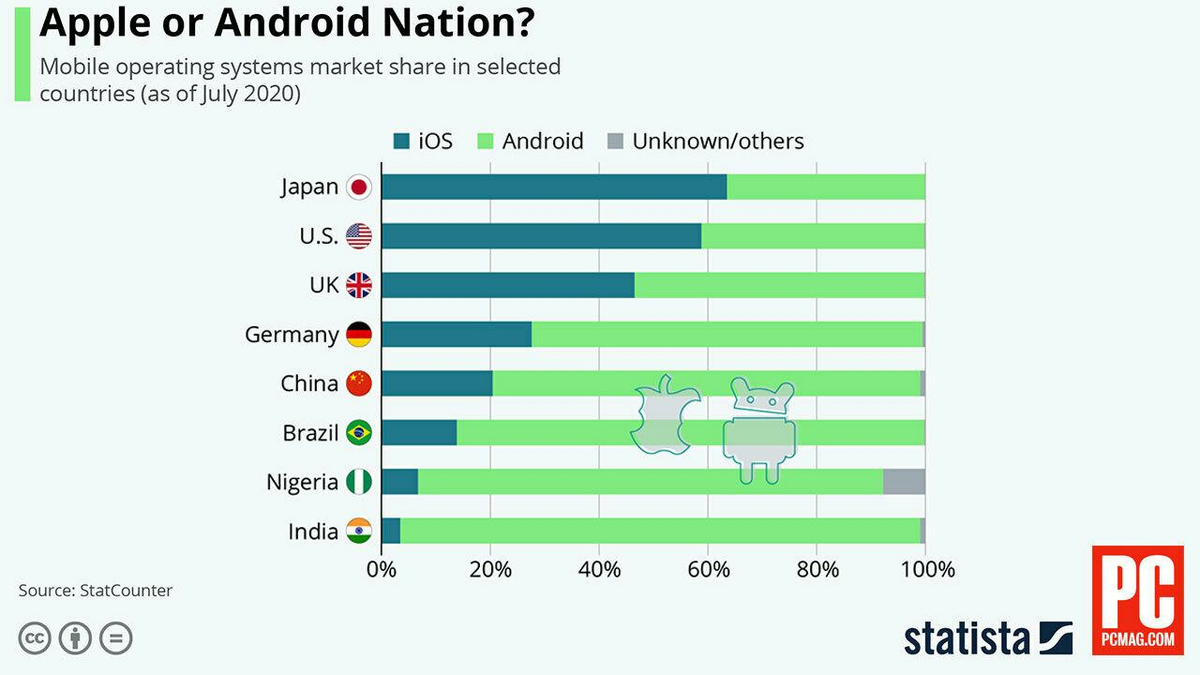
Source: PC Mag
What does this mean for developers?
Well, if you’re developing a premium app with a high price tag targeted at a very specific audience, then Apple might be a better choice.
The lower market size can be compensated with a higher spend per user.
But if you have a lower-priced app or rely on other monetization methods like ads, Android’s large user base still has the upper hand despite the lower spending power.
It is challenging to overcome Android fragmentation
Fragmentation is perhaps Android’s biggest Achilles heel—a weakness that could make development quite challenging.
If you’re unfamiliar, fragmentation refers to the sheer number of devices in the Android ecosystem.
This introduces hundreds of variations in screen size, resolution, hardware specifications, and operating system versions.
This happens because Android is open source. It doesn’t impose any standards or specifications for manufacturers who want to use the OS.
And this ultimately leads to multiple configurations that will only grow in time.
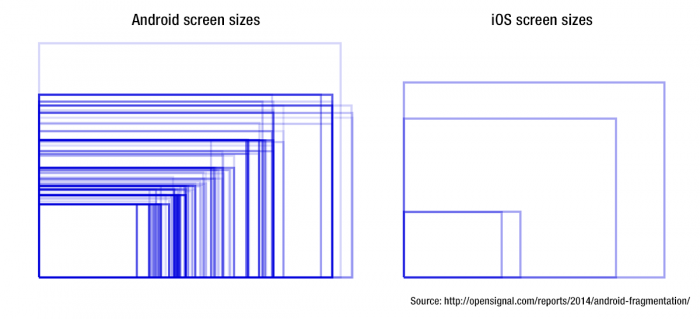
Source: Mor10
This diversity might sound great on paper, but it is a nightmare for developers.
It means that developers must create apps that can adapt seamlessly across all these device variations.
This complicates things because you must evaluate your app with multiple configurations and find the sweet spot that works for all of them.
You can choose to restrict the devices you deploy to, but that move could limit your app’s exposure. The best case is that you must still test on a dozen different devices.
Fortunately, tools like Emulator can help make fragmentation more manageable.
This feature of Android Studio allows you to run different Android devices virtually from your computer. This can simplify testing and eliminate having to acquire physical devices.
There are many threats to Android’s security
Apple is a closed ecosystem for a reason—it makes everything more secure. This is why the consensus among developers is that Android is less secure than iOS.
Again, this all leads back to Android being open source. Because of this, its source code is freely available to anyone, making it easier for hackers to study and find vulnerabilities.
In fact, tracking by CVE reveals that Android ranks second among the platforms with the most vulnerabilities of all time, with a count of more than 6,000.

Source: CVE
Now, we’re not saying that Android isn’t a secure system. We reckon it is, thanks to features like app signing and sandboxing.
However, we can’t change the fact that Android is a favorite target among hackers thanks to its ubiquity.
Adopting stringent coding practices to compensate for these vulnerabilities is your best approach.
Techniques like encryption, authentication, and code obfuscation can help make your Android apps much more resilient.
How to capitalize on the pros (and compensate for the cons)
We hope this article has given you an overview of Android development.
And if you’ve decided that Android is your OS of choice for your next project, the next question is—how do you exploit the benefits while avoiding the pitfalls?
The best way is with the right development team like DECODE.
With years of experience and dozens of successful projects in Android, we have the skills and track record to make your next app a reality.
Interested? Contact us today, and let’s schedule a consultation call.



